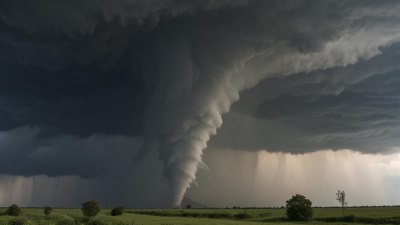The Science of Temperature Extremes in Deserts
Exploring the fascinating science behind temperature extremes in desert environments.

This image was created with the assistance of Freepik
Deserts are among the most inhospitable regions on Earth, characterized by their extreme temperatures, both hot and cold. Understanding the science of temperature extremes in deserts requires an exploration of various factors, including geography, climate, and atmospheric conditions. This article delves into the intricacies of temperature variations in these arid regions, providing insights into their causes and effects.
Deserts cover about one-third of the Earth's land surface. Their temperatures fluctuate dramatically between day and night, and this variability is one of their most defining characteristics. While many people associate deserts exclusively with scorching heat, it is equally important to note their capacity for plummeting temperatures after sunset. The arid climate of deserts leads to a minimal presence of water vapor in the atmosphere, which plays a crucial role in temperature regulation.
The Role of Geography
Geography plays a pivotal role in determining desert temperatures. Most deserts are located between 20 and 30 degrees latitude, both north and south of the equator. This positioning places them in the subtropical high-pressure zones where descending air masses limit cloud formation and precipitation, resulting in an environment ripe for temperature extremes. Furthermore, deserts are often surrounded by mountain ranges that block moisture-laden winds, creating rain shadows that exacerbate aridity.
In the case of the Sahara Desert, the world's largest hot desert, daily temperatures can soar past 50 degrees Celsius (122 degrees Fahrenheit) during the day due to direct sunlight and a lack of moisture. In contrast, nighttime temperatures can drop significantly, sometimes reaching close to freezing. The vast expanse of the desert, coupled with the absence of vegetation, contributes to rapid heat loss after sunset.
Atmospheric Conditions
The atmospheric conditions that prevail over deserts are fundamental to understanding temperature extremes. With less humidity, deserts have a lower heat capacity, meaning they can heat up quickly during the day and cool down rapidly at night. This phenomenon is termed diurnal temperature variation, which is most pronounced in arid environments. For example, in the Mojave Desert, daytime temperatures can be around 40 degrees Celsius (104 degrees Fahrenheit), while nighttime lows can dip to near freezing.
A key factor that influences these conditions is the phenomenon of radiative cooling. During the day, the land absorbs solar energy, warming the surface. However, at night, the heat trapped in the soil and sand escapes back into the atmosphere, leading to significant temperature drops. This drastic change is especially noticeable in areas with sparse vegetation, as plants typically retain heat during the night.
Local Influences and Microclimates
While larger climatic patterns dictate general trends in desert temperatures, local influences and microclimates also play significant roles. For instance, areas with greater exposure to wind may experience different temperature fluctuations compared to sheltered regions. Wind can enhance evaporation rates, further cooling the environment and affecting local weather patterns.
Moreover, variations in elevation can introduce microclimates within deserts. Higher elevations, such as those found in the Atacama Desert, can experience cooler temperatures than low-lying areas. This range is particularly evident in the Rocky Mountains' foothills, where elevation changes can create diverse biomes with distinct temperature profiles, from scorching hot valleys to cool alpine conditions.
The Impact of Climate Change
Climate change is rapidly influencing temperature extremes in deserts. Rising global temperatures have resulted in hotter average temperatures across the globe, and desert regions are no exception. Recent studies indicate that deserts are warming at a faster rate than many other ecosystems. This warming trend can exacerbate existing conditions, leading to more frequent and intense heatwaves.
As temperatures rise, the implications for local ecosystems become increasingly dire. Vegetation that has adapted to specific temperature ranges may struggle to survive. Increased aridity can also affect the animals reliant on these ecosystems for shelter and food. The biodiversity observed in desert environments is delicate and often adapted to narrow temperature ranges, meaning that any significant deviations can disrupt established food chains and habitats.
Adaptations of Desert Life
The extreme temperatures of deserts have given rise to unique adaptations among local flora and fauna. Many plant species exhibit xerophytic characteristics, allowing them to conserve water and survive in harsh conditions. Cacti, for example, have thick, fleshy stems designed to store water, and their spines reduce water loss by minimizing airflow around the plant.
Likewise, many animals have developed behavioral and physiological adaptations to cope with the extremes. Nocturnal creatures, such as the fennec fox, are active at night when temperatures are cooler, allowing them to avoid daytime heat. Other species, like the kangaroo rat, have adapted to live without ever needing to drink water, deriving necessary moisture from the seeds they consume.
Future Projections and Studies
Looking forward, ongoing studies are crucial in predicting how temperature extremes in deserts will evolve due to climate change. Researchers are utilizing advanced climate models to simulate future scenarios, analyzing how intertwined factors such as heatwaves, rainfall patterns, and species adaptability will shape these environments. The findings will inform conservation strategies aimed at protecting vulnerable desert ecosystems.
Additionally, studies are exploring potential benefits from the changes in desert climates. As temperatures rise, some desert regions may become more suitable for agriculture, given access to water sources and appropriate crops. Understanding and leveraging these dynamics could help communities adapt to changing climates while ensuring food security.
The science of temperature extremes in deserts is a multifaceted subject influenced by geography, atmospheric conditions, local microclimates, and the ongoing impacts of climate change. As these environments continue to face rapid changes, ongoing research will be critical in understanding their future, helping to protect their unique ecosystems and the life forms that inhabit them. As we navigate the complex interplay of temperature, climate, and ecology, we must also acknowledge the need for conservation efforts that safeguard the delicate balance of these arid landscapes from the impending challenges posed by an ever-changing climate.











